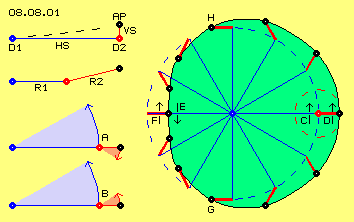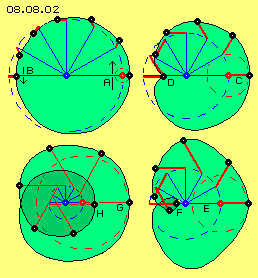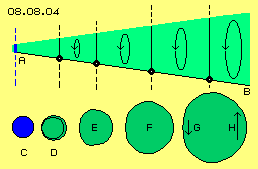Free and Bounded Aether
At the following characteristics of such uneven tracks and that enlargement of swinging radius are discussed. At picture 08.08.01 general considerations schematic are sketched.
Many Possibilities of Overlays
Both radius R1 and R2 theoretic could show any lengths and naturally both movements must not stand perpendicular but could show any angles (like sketched left side second row of picture). Consequences of such overlays are demonstrated most simple when both motions are based on same level (like assumed at the following). Both motions can turn likely fast, e.g. turning 30 degree each time-unit (like sketched downside left by blue and red segments). Revolutions however might also be different (as discussed some later). In addition, both motions can turn different sense (at A) or turnings are likely sense (at B and assumed at the following).
Around that second fulcrum, again turning motion exists, counter-clockwise (see arrow D and red marked circle), here with radius some shorter. Also that clock-hand (red) is drawn at twelve positions. At its end is placed observed aetherpoint (where that one point here also is marked at its twelve positions at its way through space).
Surface within that track is marked green for pointing out, that track is symmetric however not even. Right side, red radius shows outward and after half revolution it shows inward. Track thus is extended at the one hand (here towards right) and at the other hand, track is dented some inward (here at left side).
(Wave-) Motion with Stroke
During half of time, aetherpoint at left section of track (from H to G) comes forward only short way, while at the other half of time long way (from G to H) is done. So instead of previous assumed steady swinging at circle tracks, now realiter that swinging of aether occurs at uneven tracks.
As these uneven tracks show phases of acceleration and deceleration, aetherpoints all times move at tracks-with-stroke. At previous chapters was shown, motions of neighbouring aetherpoints (respective connecting lines) at time-shifted clocks did result second appearance of wave running all around. If instead of steady turning clocks now in reality a swinging-with-stroke exists, also these seeming waves no longer are steady but also will become waves-with-stroke.
More or less Harmony
At picture upside left, outer radius is some shorter. Resulting is also a ´round´ track, however that stroke is less intensive (see arrows A and B).
At picture upside right, outer radius is some longer (see C), longer than quarter of inner radius. Instead of that dent, now track shows a notch (see D), i.e. there occurs sharp deceleration, short standstill and following acceleration. Within gapless aether, that process produces stress, i.e. overlay by that relation of radius lengths is very inharmonious.
At picture down right, outer radius is nearby as long as inner radius (see E). Instead of previous notch, now this track builds a ´loop´ (see F, marked dark green), so direction of motion changes, however no standstill comes up. At the other hand, extension (right outside) of track however is not very harmonious.
Harmonic track will come up again, if finally the outer radius (red) is longer than inner radius (blue), like shown down left side of picture. That loop (at H, marked dark green) is much wider and reaches beyond system axis. Aetherpoint is accelerated from apex of loop (at H) and is moving outward at spiral opening track (until G), afterward is decelerated moving inward again at analogue track.
Even here only two movements of each round circles are overlaying, resulting track must not be ´round´ respective smooth at any case. Only by certain relations of radius, harmonic tracks come up (if outer radius is longer than inner, or outer radius is like or shorter than quarter of inner radius). However quite other tracks might result at overlays of circle movements of different revolutions or at differing planes and if more than two movements overlay (now here not discussed). At any case however, real aether swinging movements practically all times are motions at tracks-with-stroke.
Extension
At picture 08.08.03 red radius represents that simplified circle motion of Free Aether (see dotted circle). Start of extension from fine swinging to coarse swinging is done, when motion-centre by itself begins to swing. That inner swinging here is represented by very short blue radius (see A respective blue circle).
Like at previous picture down-left, an inner loop (dark green) comes up, embedded within wider loop (light green). Just at the begin of that additional swinging, apex of inner loop (C) is positioned near apex of outer loop (B). That ´inner trembling´ soon will enforce and thus inner loop will become smaller (like shown at previous picture down-right).
So also that critical notch could come up (at previous picture upside-right, e.g. comparable with temporary ´trembling´ of gyroscope). However that aether-stress will be covered by other varied overlays. Afterward, inner radius can grow longer and also outer radius might become longer. As long as outer radius keeps less than quarter of inner radius, harmonious tracks will result - however each will be a ´track-with-stroke´, no matter other overlays occur in addition.
At bottom row are shown cross-sections through that cone (by rough scale). Left side at C, blue surface represents motion of Free Aether as simple circle track. If its centre by itself starts additional swinging, track with wide and narrow loop comes up, like marked as green surface at D.
If afterward that central swinging reaches beyond fine swinging, motions will change into previous mentioned un-even shape of track, like marked at E. Afterward, both radius of overlaying swinging can become longer. If length of outer radius is about quarter of inner radius, motions at round track are achieved, like somehow marked at F. At any case however, that coarse swinging will show different phases with relative slow motion at depression part G and a ´stroke´ at expanded section H.
Differing Motions
At wide universe at all regions aether exists and is swinging by multiple overlays, however at narrow tracks. That ´fine swinging´ characterizes Free Aether. Embedded are areas of ´coarse swinging´ motions of Bounded Aether, which e.g. represent appearance of material particles. Transition from Free to Bounded Aether thus occurs by enlarging motion-radius. This occurs by overlay of swinging motions, at simplest case of two circle-motions.
Overlay of two swinging motions inevitably results motion at uneven track with phases of deceleration and acceleration. Bounded Aether represents areas of relative wide swinging, where all times comes up a track-section with ´stroke´.
At previous chapter overlay of a horizontal swinging HS by a vertical swinging VS was described, where observed aetherpoint AP e.g. becomes moving at diagonal track (see left-upside at picture). That inclination of seven degree (see dotted line) for example corresponds to tilt of eclipse towards sun-equator. That motion comes up by horizontal turning around system axis D1 and turning of vertical ´clocks´ arranged all around with each fulcrum D2 (like shown at previous chapters). Uneven Track
Uneven Track
At this picture right side, track of an aetherpoint (black) is marked. Around central fulcrum (blue) exists turning motion at long radius (blue), here assumed left-turning (see arrow C). A blue ´clock-hand´ is drawn at twelve positions. At end of clock-hand, second fulcrum (red) is placed, wandering within space at circle track (see blue dotted circle).
Right side (at C and D) both movements add, aetherpoint moves forward rather fast within that time-unit, like marked by wide distance between its positions there. Left side (at E and F) both movements are contrary, so aetherpoint moves forward only short distance at that time-unit. At downside section of track (from E to D) an acceleration occurs, while at upper section of track (from D to E) motion speed is decelerated.
 At previous example, lengths of inner and outer radius had relation of about 4:1 resulting a relative ´round´ track. Picture 08.08.02 shows some other relations, resulting different characteristics of tracks. At each upper half, positions of radius and aetherpoints are marked, at each downside half only contours of tracks are marked.
At previous example, lengths of inner and outer radius had relation of about 4:1 resulting a relative ´round´ track. Picture 08.08.02 shows some other relations, resulting different characteristics of tracks. At each upper half, positions of radius and aetherpoints are marked, at each downside half only contours of tracks are marked.
 Motion of Free Aether is running at tracks resulting of overlays of large number of movements. There are no long sections running straight or at arc of a circle. Movements look like ´spiralclustertracks´, build by quant-small sections of different directions, speeds and curvature. So if at the following now movement of Free Aether is drawn by circle track, it´s extremely simplified.
Motion of Free Aether is running at tracks resulting of overlays of large number of movements. There are no long sections running straight or at arc of a circle. Movements look like ´spiralclustertracks´, build by quant-small sections of different directions, speeds and curvature. So if at the following now movement of Free Aether is drawn by circle track, it´s extremely simplified. At picture 08.08.04 that cone-shaped extension of swinging from Free Aether (here left side at A, marked blue) towards coarse swinging of Bounded Aether (here right side at B) once more is drawn. Four aetherpoints (black) are marked at a connecting line, which is swinging at that cone-mantle at each wider tracks (and parallel all neighbours of that plane are swinging).
At picture 08.08.04 that cone-shaped extension of swinging from Free Aether (here left side at A, marked blue) towards coarse swinging of Bounded Aether (here right side at B) once more is drawn. Four aetherpoints (black) are marked at a connecting line, which is swinging at that cone-mantle at each wider tracks (and parallel all neighbours of that plane are swinging).
Even aether does not show any gaps, still motion is possible within that plasma. That motion is perpetual, as a whole can never be diminished. However at local areas, motion intensity can be increased e.g. in shape of coarse swinging. In general, all motions can never occur at pure circles but all times only at tracks-with-stroke, so by different phases. These differing motions naturally essentially affect all appearances of Bounded Aether, like following chapters will show.
08.09. All-Pressure
08. Something Moving